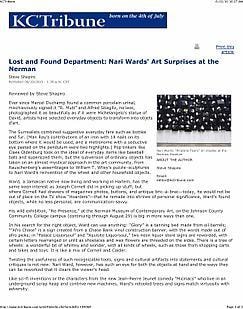
Lost and Found Department: Nari Ward's Art Surprises at the Nerman
Steve Shapiro
Ever since Marcel Duchamp found a common porcelain urinal, mischievously signed it "R. Mutt" and Alfred Stiegltz, no less, photographed it as beautifully as if it were Michelangelo's statue of David, artists have selected everyday objects to transform into objets d'art.
The Surrealists combined suggestive everyday fare such as bottles and fur. (Man Ray's contributions of an iron with 14 nails on its bottom where it would be used, and a metronome with a seductive eye pasted on the pendulum were two highlights.) Pop tinkers like Claes Oldenburg took on the ideal of everyday items like baseball bats and supersized them; but the subversion of ordinary objects has taken on an almost mystical approach in the art community, from Rauschenberg's assemblages to William T. Wiley's puzzle-sculptures to Nari Ward's reinvention of the wheel and other household objects.
Ward, a Jamaican native now living and working in Harlem, has the same keen interest as Joseph Cornell did in picking up stuff; but where Cornell had drawers of magazines photos, buttons, and antique bric-à-brac—today, he would not be out of place on the TV show "Hoarders"—that he remade into shrines of personal significance, Ward's found objects, while no less personal, are communication-savvy.
His wild exhibition, "Re-Presence," at the Nerman Museum of Contemporary Art, on the Johnson County Community College campus (continuing through August 29) is big in more ways than one.
In his search for the right object, Ward can use anything: "Glory" is a tanning bed made from oil barrels; ""Afro Chase" is a sign created from a Chase Bank vinyl construction banner, with the words made out of afro picks; in "Palace Liquorsoul" and "Xquisite Liquorsoul," two neon liquor store signs are reworded, with certain letters rearranged or unlit as shoelaces and wax flowers are threaded on the sides. There is a tree of wheels: a wonderful bit of whimsy and wonder, with all kinds of wheels, such as those from shopping carts and bikes and toys. It is like a mix of Cornell and Calder.
Twisting the usefulness of such recognizable tools, signs and cultural artifacts into statements and cultural critiques is not new: Nari Ward, however, has such an eye for both the objects at hand and the ways they can be reworked that it clears the viewer's head.
Like sci-fi inventions or the characters from the new Jean-Pierre Jeunet comedy "Micmacs" who live in an underground scrap heap and contrive new machines, Ward's retooled trees and signs match virtuosity with adversity.
The message is in the medium: found art, found ideas. Wandering around the Nerman, which is perfectly situated for this kind of show, with its high ceilings and large blank galleries, the viewer can make his way around many of the works: they are as intriguing close up as from a distance—but the effect of the various materials (the shoes, shells, shoe laces, and televisions) draws the viewer in.
Though The New Yorker's art critic, Peter Schjeldahl, once wrote of one of Ward's larger installations' "rather forced symbolism," liveliness abounds at the Nerman without added emphasis. One viewing will not pack it all in, like so many movies nowadays or museum shows: one man's junk is another man's key to the universe.
Ward keeps the viewer guessing. Like Olafur Eliasson and Nam June Paik with their elaborate pieces combining technology and simplicity, and Joseph Beuys before them all, Ward's vision in re-animating dead stuff, the detritus of society, the cast-offs, as well as changing our perceptions of things like liquor-store signs, allows his art works to build on one another.
Many artists are well served by one piece, if it is commanding enough; Nari Ward's art gains by volume. His centerpiece, the wall-length "Airline Tears," some fifty-plus used Sony televisions that are seen from the back with their jutting behinds in our faces (and tissues attached to the sets), cannot be simplified as meaning X.
One thought leads to the next and the next—before the viewer knows it, those TVs suddenly seem like a new thing again. Now the phrase "watching television" will mean something entirely different. Art, after all, is in the eyes of the beholder and the readily bewitched.
